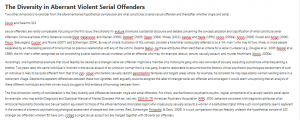The Diversity in Aberrant Violent Serial Offenders

Two other dimensions to consider from the aforementioned hypothetical sample pool are what constitutes a serial sexual offender and thereafter whether single and serial
Kocsis and Palermo 323
sexual offenders are validly comparable. Focusing on the first issue, the scholarly lit- erature chronicles substantial discourse and debate concerning the conceptualization and classification of what constitute serial offenders. Some examples of this literature include Dietz, Hazelwood, and Warren (1990); Dobbert (2009); Egger (1984); Hickey (2012); Keeney and Heide (1995); Kocsis (2006a); Kocsis (2008); Purcell and Arrigo (2006); Proulx, Beauregard, Cusson, and Nicole (2007); and Schlesinger (2004). By way of simple illustration of this concept, consider a hired killer (colloquially referred to as a “hit-man”) who may kill two, three, or more people separated by an interceding period of time but has no previous relationship with any of the victims. Despite featur- ing these attributes often identified as criteria for a serial murderer (e.g., Douglas et al., 2006; Ressler et al., 1988), the hit-man is often recognized as not constituting a serial sadistic sexual murderer unlike an offender who may, for example, abduct, torture, sexually assault, and murder hitchhikers (Kocsis, 2006a).
Accordingly, one hypothetical example that could feasibly be viewed as a stranger serial sex offender might be a member of a motorcycle gang who was convicted of sexually assaulting a prostitute while frequenting a brothel. Two years later, this same individual is involved in the sexual assault of an unknown woman from a rival gang. It seems reasonable to assume that the forensic clinical psychiatric/psychological assessment of such an individual is likely to be quite different from that of an indi- vidual who harbors sexually sadistic gerontophilic fantasies and targets areas where, for example, he considers he may rape elderly women residing alone in a retirement village. Despite the apparent differences between these two vignettes, both arguably could be assigned the label of stranger serial sex offender and once again it would seem unsurprising that an analysis of these different individuals and their crimes would struggle to find evidence of homology between them.
The final dimension worthy of consideration is the likely diversity and differences between single and serial offenders. Put simply, are the forensic psychiatric/psycho- logical components of a sexually sadistic serial rapist, for example, who may exhibit Diagnostic and Statistical Manual of Mental Disorders (4th ed., text rev.; DSM-IV-TR; American Psychiatric Association [APA], 2000, behaviors consistent with diagnostic attributes of an Antisocial Personality Disorder and Sexual Sadism equivalent to those of the aforementioned intoxicated rapist who impetuously sexually assaults a woman in a befuddled state? While such incompatibility seems apparent in the context of a forensic psychiatric/psychological assessment of people and their crimes (Park, Schlesinger, Pinizzotto, & Davis, 2008), it is such comparisons that can feasibly underpin the hypothetical sample of 100 stranger sex offenders wherein 62 have com- mitted a single sexual assault but are merged together with 38 serial sex offenders.